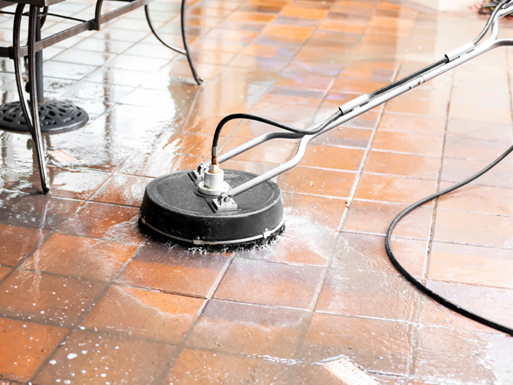
1. Clear the Area
- Remove Any Furniture or Objects: If cleaning a floor, move furniture and any other objects away from the area to give yourself space to clean.
- Sweep or Vacuum: Use a broom or vacuum to remove dirt, dust, and debris from the tiles. Be thorough, especially around the edges, where dirt tends to accumulate.
2. Pre-Spray with Tile & Grout Cleaning Chemical
Before applying your cleaning solution, spray a tile and grout cleaner generously over the grout lines and tile surfaces. This pre-spray helps loosen any stubborn dirt, grime, or soap scum, making it easier to scrub and clean effectively. Allow the pre-spray to sit for a few minutes to break down dirt and stains.
3. Prepare the Cleaning Solution
- Store-Bought Cleaner: If you’re using a commercial tile and grout cleaner, follow the instructions on the label.
- Homemade Cleaner: For a natural cleaner, you can mix:
- 1/2 cup of vinegar
- 1/2 cup of baking soda
- 1 cup of warm water This mixture works well for both cleaning the tiles and grout.
4. Apply the Cleaner to the Tiles and Grout
- Spray or Pour the Cleaner: Generously spray or pour the cleaning solution onto the tiles and grout lines. Make sure to cover all grout lines where dirt and mildew accumulate.
- Let it Sit: Allow the cleaner to sit on the grout and tiles for 5-10 minutes. This helps break down grime, stains, and soap scum, making it easier to scrub.
5. Scrub the Grout Lines
- Use a Stiff-Bristled Brush: Use a stiff-bristled brush to scrub the grout lines. Scrub in a circular motion to lift dirt and stains.
- Use a Toothbrush for Small Areas: For tight grout lines or corners, use an old toothbrush to scrub in small sections.
- Focus on Problem Areas: If you have stubborn stains or discoloration, give those areas extra attention. You may need to apply a bit more cleaner or use a steam cleaner for tough spots.
6. Scrub the Tile Surfaces
- Tile Scrubbing: While focusing mostly on the grout lines, you can also scrub the tile surfaces with the same brush. For smooth, non-porous tiles, a soft-bristled brush or sponge works well.
- For Stubborn Stains: If you have stubborn stains on the tile itself (e.g., soap scum), try using a mixture of equal parts vinegar and water or a specialized tile cleaner.
7. Rinse the Area
- Wipe with a Damp Cloth: After scrubbing, wipe down the tiles and grout with a damp microfiber cloth to remove excess cleaner, dirt, and grime.
- Use Clean Water: Rinse your mop or cloth frequently in clean water to prevent spreading dirt back onto the tiles.
8. Dry the Tiles
- Dry with a Microfiber Cloth: Once the tiles are clean and rinsed, dry the surface with a clean microfiber cloth or towel. This helps avoid water spots and streaks, especially on shiny tiles like porcelain or ceramic.
- Ensure the Grout Is Dry: Make sure the grout lines are also dry to prevent mold or mildew from forming.
9. Seal the Grout (Optional but Recommended)
- Apply Grout Sealer: After cleaning and drying the grout, consider applying a grout sealer. This will protect the grout from future stains and make it easier to clean in the future.
- Follow the Manufacturer’s Instructions: If using a commercial sealer, follow the instructions carefully. Usually, it involves applying the sealer to the grout lines with a small applicator or sponge, letting it sit for a few minutes, and then wiping off the excess

